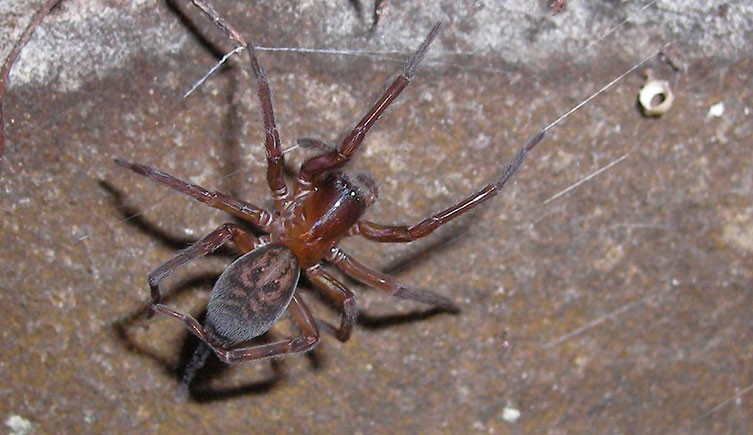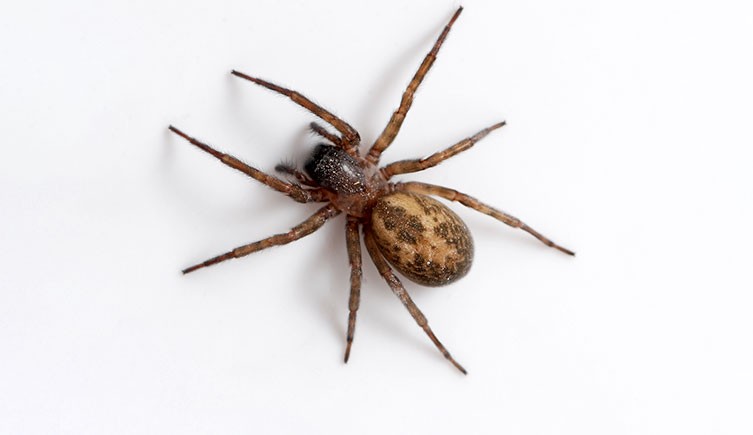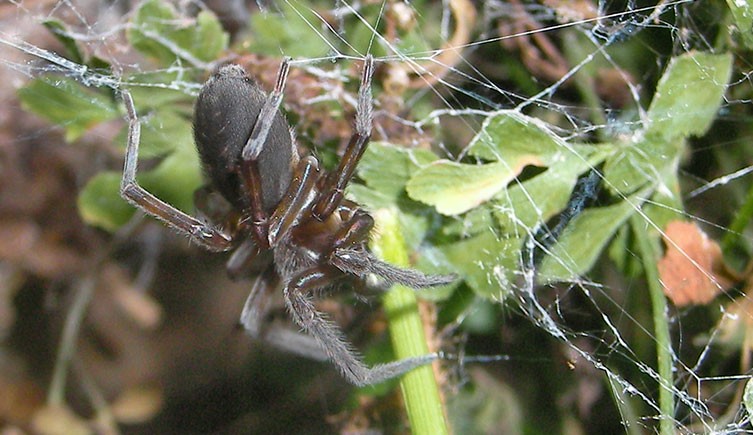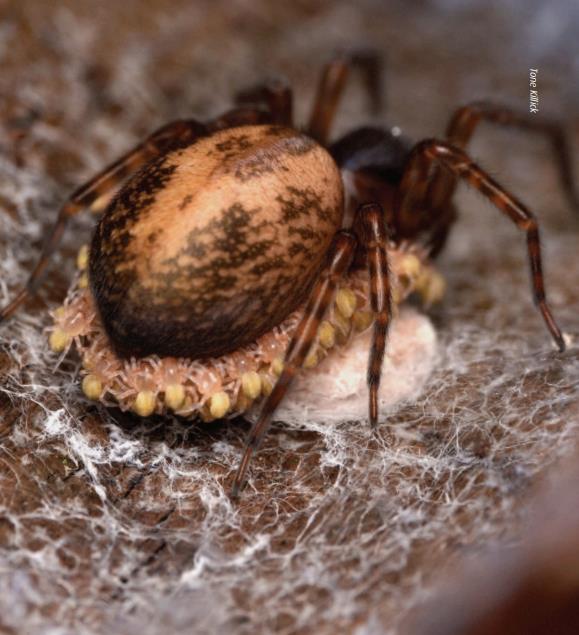
Lace web spider – Amaurobius species
Overall size: 20mm
Other names: Funnel weavers
Season: all year round. Usually found outdoors on walls, fencing and clutter around the garden, but most common in homes in autumn when males leave their webs to search for female spiders. Also common after heavy rain when they become flooded out of their own homes.
A medium-sized spider, usually brown and frequently having yellowish markings on the abdomen. Three related species live in Britain, living in tubular retreats within holes in walls, bark, etc. Their web is made of silk with a woolly texture due to extremely fine and sticky fibres, which gives them the name lace-weavers.
Adults are 5 to 15 mm long. Males are smaller than females but with longer legs. Amaurobius ferox is the largest on average, and the darkest. The other two are hard to tell apart, but if in house or garden it’s probably an A. similis, while if in woodland it’s more likely an A. fenestralis.
They superficially resemble false widow spiders (Steatoda sp.) and people often worry about them, but they are harmless.
Life cycle
Females live for two years, while males only a few months. In late summer and autumn males wander in search of females. They strum silk threads in females’ webs to advertise their presence. The eggs are laid in a sac within the retreat in the summer of the following year. Females frequently die and are eaten by spiderlings before they disperse.
The web
The web is a tangled mesh of threads surrounding a circular retreat leading into a crevice, usually on a vertical surface. When fresh, it has a lace-like appearance and a bluish colour, and it is very sticky. The web is spun by night, but the spiders are ready to respond to any insect stuck in it at any time of day.

How to recogniseLaceweb spiders
In Britain, we have just three species in thefamily of Laceweb spiders (Amaurobiidae):Amaurobius similis, Amaurobius fenestralisand the Black Laceweb Spider Amaurobiusferox. Here we will call them fenestralis,similis and ferox. Similis must be one ofBritain’s most frequently encounteredspiders because it inhabits holes andcrevices around buildings across thecountry. The three species look very similarbut differ slightly in size, overall colorationand preferred habitat (see FACT FILE below).Similis and fenestralis are particularlysimilar and individually variable; they canonly be reliably told apart with microscopicexamination.

Prey capture
Although largely active at night, when theylurk at the entrance to their retreats or extendtheir webs, these spiders will also dash out –at high speed – when the web is disturbedduring the day. The spiders feed mainly oncrawling invertebrates, but aerial insects arealso taken. Unlike most of our spider families,Laceweb spiders have an additional silkspinning apparatus, called a cribellum, in frontof the normal spinnerets (see Factsheet 1)under the abdomen. This is a slit-like structurefrom which woolly, non-sticky, silk is combedout using a double row of bristles (thecalamistrum) on the back legs. This silk actsrather like the woolly-side of Velcro,entangling the legs of potential prey and alsoretaining it by molecular attraction (Van derWaals forces). On a flat surface, such as agarage door or on the cut edge of a densegarden hedge, the web spreads out like a doilyfrom a central cavity, within which the spidermakes its home. On complex surfaces, theweb is more of an untidy sheet. When freshlyproduced, the silk has a bluish tinge.

Extraordinary life history
All three species can be found as adults inmost months of the year. Most similis andfenestralis males are mature in latesummer/autumn, whereas mature femalesare found throughout the year, with spring andautumn peaks. Ferox has more defined peaks- in spring for males and early summer forfemales. Similis egg-sacs are typicallyproduced in June and July, the parents havingmated the previous autumn. The motherguards the egg-sac for about a month, beforethe young emerge. Some amazing behaviourfollows. After two or three days the femalebegins to cover her young with a fine layer ofsilk and they become very active, eventuallymoving under her abdomen, like pigletsround teats. Indeed, they are being fed, butnot on milk. The female produces special‘trophic’ (food) eggs, which are avidlyconsumed by the young and help themprogress towards their second moult, somefive days later. The mother then taps andpulls at the silk, activating her previouslyquiet offspring, which swarm all over her,biting wherever they can. Eventually she isoverwhelmed and eaten, a process calledmatriphagy (literally ‘mother-eating’!). Thesewell-fed young disperse some 14 days later,larger, and in a much better nutritional state,as a result of their mother’s provisioning andultimate sacrifice. The other two Lacewebspecies behave similarly.
